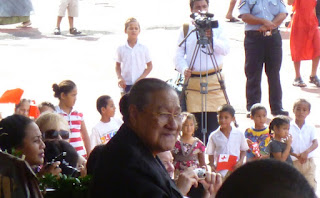As the first day of Fall comes and goes, we're getting some relief from the heat with a few days of very stormy weather. Periods of intense wind and rain with spells of relative calm, and then another downpour.
Here at Tonga Tangos we've been continuing to adjust to our new situation, life without Kathy. Here's how Lilo feels about her being gone:
She's a very sensitive cat.
And I miss her too, and while I'm not exactly hiding in the mat like Lilo I am having to work at getting out and finding ways to socialize. Kathy and I are able to spend some time every day doing some text "chatting" to keep up with each other's doings, and we keep hoping that Skype will actually allow us to talk, but that hasn't happened for a while. Anyway, faithful readers not from our home in the Pacific Northwest please be advised that she is integrating nicely back into what she likes to call her "real life" and seems to be doing fine.
As for me, I continue to wonder at the ability of a Tongan institution that is basically broke and in debt to continue to function. At my little university we are holding classes as usual; our students are attending in their usual fashion, and life goes on more or less as normal. But now when the one copier we have runs out of toner and there is no replacement cartridge on hand (not an unusual situation), we now have the added problem of not enough cash on hand to go buy more. So it may be a few days before some student makes a fee payment and provides the cash needed to make the purchase, and in the meantime we are unable to supply the written materials for our instruction. Staff and other faculty have only been able to take small draws against the salaries they are owed. Yet they continue to come every day and teach.
This pattern is not unusual in Tonga. As an example I was discussing this situation with one of my PC colleagues the other day, and she was relating how a non-profit group she socializes with hasn't paid their bills for a few months now, yet they go on without any apparent worry. That situation amazes her as much as much as mine amazes me.
There are many stories like this around Tonga. People here have a different relationship to money, one that is very difficult for us Westerners to get our heads around. (Someday I might try to write about the
sai pe--things are just fine, no worries-- attitude that suffuses much of life here.)
On the instructional front, I'm teaching a new course on Critical Thinking which is now required for all our students seeking a degree. With guidance from my friend Cindy back home at Blue Mountain Community College and materials from The Foundation for Critical Thinking I am plowing ahead to convert these students with a lifetime of experience as rote learners trained to always supply the "right" answer into active inquirers who seek to question, evaluate, pursue evidence, and form reasoned judgments based on rational analysis. It is a struggle, but there are glimmers of hope.
Here's Lilo again, telling me to stop "kai po"ing (hogging) the taro chips that I like to have with my daily beer; she has a way of letting her wants be known.
I've taken to going on long Sunday bike rides, usually with friend who is here for a few years working as a nurse. She is a true Kiwi, quite the outdoorswoman, and Sundays are great days to ride because there is so little traffic on the roads. So besides a really good dose of exercise, I'm getting to places on the island I haven't been to before, like Tsunami Rock, a big chunk of coral reef sitting a couple hundred meters inland that could only have arrived there courtesy of a tsunami wave. One day we rode to the Abel Tasman landing site on the Northwesternmost tip of the island. Here's a couple photos from that day:
I know this is hard to make out, just as it is in real life; it is a deadly Stonefish, that looks pretty much like the rocks and coral surrounding it as it lies perfectly still. Stepping on one of these critters can result in serious injury, as there are deadly toxins in the base of its fins. We were lucky to spot it before it caused us any trouble.
Apparently someone decided they should make it easier for tourists to be able to get down into the water from the viewing platform, so this is the ladder they built. Yes, it is every bit as steep and precarious as it looks. But after riding the 20 kms. or so to get there in the summer heat, not getting into the water to cool off was not an option. One of the benefits of cycling on a tropical island.
I'll close this post with another benefit of living here: the gorgeous color that surrounds us; this orchid grows by my front porch.
Next post: How I spent my school break exploring Vava'u.








































